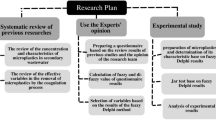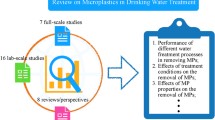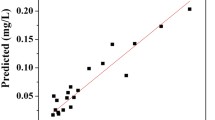Abstract
Background and purpose
The ubiquitous presence of microplastics (MPs) in aquatic environments has been studied widely. Due to toxicological impacts of MPs and associated contaminants, it is crucial to understand the performance of MPs removal in drinking water treatment plants (DWTPs). Few studies have investigated removal characteristics of MPs via coagulation/flocculation processes, yet removal characterization of polypropylene microplastics (PPMPs) in this process is poorly understood. This study aims to optimize coagulation of virgin PPMPs in conventional DWTPs.
Methods
In this study, samples were synthesized through response surface methodology (RSM), polyaluminium chloride (PACl) was applied as a conventional coagulant to remove PPMPs in the coagulation/flocculation process, which has the least density among common polymers and is one of the most abundant manufactured polymers worldwide. A particle size analyzer (PSA) was used to measure floc size at different pH levels. Additionally, a zeta potential analyzer was used to measure stability of the flocs at different pH.
Results
Base on the experimental range in Design-Expert, results revealed that the optimum removal rate was predicted to be at pH 9, PACl concentration of 200 ppm, polyacrylamide (PAM) concentration of 21 ppm, and PPMPs size of d < 0.25 mm. According to the predicted optimum condition, actual and predicted removal rates were 18.00 ± 1.43% and 19.69%, respectively.
Conclusion
According to this study, PACl is not capable of efficiently removing virgin PPMPs in DWTPs, thereby exposing humans to eco-toxicological impacts of PPMPs through tap water.






Similar content being viewed by others
Data availability
Not applicable.
References
Geyer R, Jambeck JR, Law KL. Production, use, and fate of all plastics ever made. Sci Adv. 2017;3:e1700782. https://doi.org/10.1126/sciadv.1700782.
Borrelle SB, Ringma J, Law KL, Monnahan CC, Lebreton L, McGivern A, Murphy E, Jambeck J, Leonard GH, Hilleary MA, Eriksen M, Possingham HP, De Frond H, Gerber LR, Polidoro B, Tahir A, Bernard M, Mallos N, Barnes M, Rochman CM. Predicted growth in plastic waste exceeds efforts to mitigate plastic pollution. Science. 2020;369:515–1518. https://doi.org/10.1126/science.aba3656.
PlasticsEurope, Plastics – the Facts 2019. An analysis of European plastics production, demand and waste data. 2019. www.plasticseurope.org
Jambeck JR, Geyer R, Wilcox C, Siegler TR, Perryman M, Andrady A, Narayan R, Law KL. Plastic waste inputs from land into the ocean. Science. 2015;347:768–71. https://doi.org/10.1126/science.1260352.
Walker TR. Drowning in debris: Solutions for a global pervasive marine pollution problem. Mar Pollut Bull. 2018;126(338):338–338. https://doi.org/10.1016/j.marpolbul.2017.11.039.
Kutralam-Muniasamy G, Pérez-Guevara F, Elizalde-Martínez I, Shruti VC. Review of current trends, advances and analytical challenges for microplastics contamination in Latin America. Environ Pollut. 2020;267:115463. https://doi.org/10.1016/j.envpol.2020.115463.
Schmaltz E, Melvin EC, Diana Z, Gunady EF, Rittschof D, Somarelli JA, Virdin J, Dunphy-Daly MM. Plastic pollution solutions: emerging technologies to prevent and collect marine plastic pollution. Environ Int. 2020;144:106067. https://doi.org/10.1016/j.envint.2020.106067.
Tang Y, Liu Y, Chen Y, Zhang W, Zhao J, He S, Yang C, Zhang T, Tang C, Zhang C, Yan Z. A review: Research progress on microplastic pollutants in aquatic environments. Sci Tot Environ. 2020;42572. https://doi.org/10.1016/j.scitotenv.2020.142572
Morten WR, Alexis L, Michael H. Mapping of global plastics value chain and plastics losses to the environment: with a particular focus on marine environment. UN Environment Program. 2018;1–99. http://hdl.handle.net/20.500.11822/26745
Jaikumar G, Brun NR, Vijver MG, Bosker T. Reproductive toxicity of primary and secondary microplastics to three cladocerans during chronic exposure. Environ Pollut. 2019;249:638–46. https://doi.org/10.1016/j.envpol.2019.03.085.
Rochman CM. The complex mixture, fate and toxicity of chemicals associated with plastic debris in the marine environment. In: Bergmann M, Gutow L, Klages M. editors. Marine anthropogenic litter. Springer, Cham. 2015;117–140. https://doi.org/10.1007/978-3-319-16510-3_5
Andrady AL. Persistence of plastic litter in the oceans. In: Bergmann M, Gutow L, Klages M. editors. Marine anthropogenic litter, Springer, Cham. 2015;57–72. https://doi.org/10.1007/978-3-319-16510-3_3
El Hadri H, Gigault J, Maxit B, Grassl B, Reynaud S. Nanoplastic from mechanically degraded primary and secondary microplastics for environmental assessments. NanoImpact. 2020;17:100206. https://doi.org/10.1016/j.impact.2019.100206.
Su L, Xue Y, Li L, Yang D, Kolandhasamy P, Li D, Shi H. Microplastics in Taihu Lake, China. Environ Pollut. 2016;216:711–9. https://doi.org/10.1016/j.envpol.2016.06.036.
Mao R, Hu Y, Zhang S, Wu R, Guo X. Microplastics in the surface water of Wuliangsuhai Lake, northern China. Sci Total Environ. 2020;723:137820. https://doi.org/10.1016/j.scitotenv.2020.137820.
Anderson PJ, Warrack S, Langen V, Challis JK, Hanson ML, Rennie MD. Microplastic contamination in Lake Winnipeg, Canada. Environ Pollut. 2017;225:223–31. https://doi.org/10.1016/j.envpol.2017.02.072.
Lin L, Zuo LZ, Peng JP, Cai LQ, Fok L, Yan Y, Li HX, Xu XR. Occurrence and distribution of microplastics in an urban river: a case study in the Pearl River along Guangzhou City, China. Sci Total Environ. 2018;644:375–81. https://doi.org/10.1016/j.scitotenv.2018.06.327.
Slootmaekers B, Catarci Carteny C, Belpaire C, Saverwyns S, Fremout W, Blust R, Bervoets L. Microplastic contamination in gudgeons (Gobio gobio) from Flemish rivers (Belgium). Environ Pollut. 2019;244:675–84. https://doi.org/10.1016/j.envpol.2018.09.136.
Wang S, Chen H, Zhou X, Tian Y, Lin C, Wang W, Zhou K, Zhang Y, Lin H. Microplastic abundance, distribution and composition in the mid-west Pacific Ocean. Environ Pollut. 2020;264:114125. https://doi.org/10.1016/j.envpol.2020.114125.
Kor K, Mehdinia A. Neustonic microplastic pollution in the Persian Gulf. Mar Pollut Bull. 2020;150:110665. https://doi.org/10.1016/j.marpolbul.2019.110665.
Nematollahi MJ, Moore F, Keshavarzi B, Vogt RD, Nasrollahzadeh Saravi H, Busquets R. Microplastic particles in sediments and waters, south of Caspian Sea: frequency, distribution, characteristics, and chemical composition. Ecotoxicol Environ Saf. 2020;206:111137. https://doi.org/10.1016/j.ecoenv.2020.111137.
Karbalaei S, Golieskardi A, Hamzah HB, Abdulwahid S, Hanachi P, Walker TR, Karami A. Abundance and characteristics of microplastics in commercial marine fish from Malaysia. Mar Pollut Bull. 2019;148:5–15. https://doi.org/10.1016/j.marpolbul.2019.07.072.
Karbalaei S, Golieskardi A, Watt DU, Bioret M, Hanachi P, Walker TR, Karami A. Analysis and inorganic composition of microplastics in commercial Malaysian fish meals. Mar Pollut Bull. 2020;150:110687. https://doi.org/10.1016/j.marpolbul.2019.110687.
Pivokonsky M, Cermakova L, Novotna K, Peer P, Cajthaml T, Janda V. Occurrence of microplastics in raw and treated drinking water. Sci Total Environ. 2018;643:1644–51. https://doi.org/10.1016/j.scitotenv.2018.08.102.
Pivokonský M, Pivokonská L, Novotná K, Čermáková L, Klimtová M. Occurrence and fate of microplastics at two different drinking water treatment plants within a river catchment. Sci Total Environ. 2020;741:140236. https://doi.org/10.1016/j.scitotenv.2020.140236.
Gündoğdu S, Çevik C, Güzel E, Kilercioğlu S. Microplastics in municipal wastewater treatment plants in Turkey: a comparison of the influent and secondary effluent concentrations. Environ Monit Assess. 2018;190(11):626. https://doi.org/10.1007/s10661-018-7010-y.
Wang Z, Lin T, Chen W. Occurrence and removal of microplastics in an advanced drinking water treatment plant (ADWTP). Sci Tot Environ. 2020;700:134520. https://doi.org/10.1016/j.scitotenv.2019.134520.
Adib D, Mafigholami R, Tabeshkia H. Identification of microplastics in conventional drinking water treatment plants in Tehran. Iran J Environ Health Sci Eng. 2021. https://doi.org/10.1007/s40201-021-00737-3.
Prata JC. Microplastics in wastewater: State of the knowledge on sources, fate and solutions. Mar Pollut Bull. 2018;129(1):262–5. https://doi.org/10.1016/j.marpolbul.2018.02.046.
Gies EA, LeNoble JL, Noel L, Etemadifar A, Bishay F, Hall ER, Ross PS. Retention of microplastics in a major secondary wastewater treatment plant in Vancouver, Canada. Mar Pollut Bull. 2018;133:553–61. https://doi.org/10.1016/j.marpolbul.2018.06.006.
Mintenig SM, Int-Veen I, Löder MGJ, Primpke S, Gerdts G. Identification of microplastic in effluents of waste water treatment plants using focal plane array-based micro-Fourier-transform infrared imaging. Water Res. 2017;108:365–72. https://doi.org/10.1016/j.watres.2016.11.015.
Simon M, van Alst N, Vollertsen J. Quantification of microplastic mass and removal rates at wastewater treatment plants applying Focal Plane Array (FPA)-based Fourier Transform Infrared (FT-IR) imaging. Water Res. 2018;142:1–9. https://doi.org/10.1016/j.watres.2018.05.019.
Schmidt C, Kumar R, Yang S, Büttner O. Microplastic particle emission from wastewater treatment plant effluents into river networks in Germany: Loads, spatial patterns of concentrations and potential toxicity. Sci Tot Environ. 2020;737:139544. https://doi.org/10.1016/j.scitotenv.2020.139544.
Conley K, Clum A, Deepe J, Lane H, Beckingham B. Wastewater treatment plants as a source of microplastics to an urban estuary: removal efficiencies and loading per capita over one year. Water Res X. 2019;3:100030. https://doi.org/10.1016/j.wroa.2019.100030.
Kay P, Hiscoe R, Moberley I, Bajik L, McKenna M. Wastewater treatment plants as a source of microplastics in river catchments. Environ Sci Pollut Res. 2018;25:20264–7. https://doi.org/10.1007/s11356-018-2070-7.
Calderon EA, Hansen P, Rodríguez A, Blettler M, Syberg K, Khan FR. Microplastics in the digestive tracts of four fish species from the Ciénaga Grande de Santa fMarta Estuary in Colombia. Water Air Soil Pollut. 2019;230:257. https://doi.org/10.1007/s11270-019-4313-8.
Wardlaw C, Prosser RS. Investigation of microplastics in freshwater mussels (Lasmigona Costata) from the Grand River watershed in Ontario. Canada Water Air Soil Pollut. 2020;231(8):1–14. https://doi.org/10.1007/s11270-020-04741-5.
Naidoo T, Glassom D. Decreased growth and survival in small juvenile fish, after chronic exposure to environmentally relevant concentrations of microplastic. Mar Pollut Bull. 2019;145:254–9. https://doi.org/10.1016/j.marpolbul.2019.02.037.
Huang JS, Koongolla JB, Li HX, Lin L, Pan YF, Liu S, He WH, Maharana D, Xu XR. Microplastic accumulation in fish from Zhanjiang mangrove wetland. South China Sci Tot Environ. 2020;708:134839. https://doi.org/10.1016/j.scitotenv.2019.134839.
Ahrendt C, Perez-Venegas DJ, Urbina M, Gonzalez C, Echeveste P, Aldana M, Pulgar J, Galbán-Malagón C. Microplastic ingestion cause intestinal lesions in the intertidal fish Girella laevifrons. Mar Pollut Bull. 2020;151:110795. https://doi.org/10.1016/j.marpolbul.2019.110795.
Wang W, Ge J, Yu X. Bioavailability and toxicity of microplastics to fish species: a review. Ecotoxicol Environ Saf. 2020;189:109913. https://doi.org/10.1016/j.ecoenv.2019.109913.
Qiang L, Cheng J. Exposure to Polystyrene microplastics impairs Gonads of Zebrafish (Danio Rerio). Chemosphere. 2021;263:128161. https://doi.org/10.1016/j.chemosphere.2020.128161.
Tong H, Jiang Q, Hu X, Zhong X. Occurrence and identification of microplastics in tap water from China. Chemosphere. 2020;252:126493. https://doi.org/10.1016/j.chemosphere.2020.126493.
Cox KD, Covernton GA, Davies HL, Dower JF, Juanes F, Dudas SE. Human consumption of microplastics. Environ Sci Technol. 2019;53:7068–74. https://doi.org/10.1021/acs.est.9b01517.
Fiorentino I, Gualtieri R, Barbato V, Mollo V, Braun S, Angrisani A, Turano M, Furia M, Netti PA, Guarnieri D, Fusco S, Talevi R. Energy independent uptake and release of polystyrene nanoparticles in primary mammalian cell cultures. Exp Cell Res. 2015;330(2):240–7. https://doi.org/10.1016/j.yexcr.2014.09.017.
Forte M, Iachetta G, Tussellino M, Carotenuto R, Prisco M, De Falco M, Laforgia V, Valiante S. Polystyrene nanoparticles internalization in human gastric adenocarcinoma cells. Toxicol In Vitro. 2015;31:126–36. https://doi.org/10.1016/j.tiv.2015.11.006.
Sillanpää M, Ncibi MC, Matilainen A, Vepsäläinen M. Removal of natural organic matter in drinking water treatment by coagulation: a comprehensive review. Chemosphere. 2018;190:54–71. https://doi.org/10.1016/j.chemosphere.2017.09.113.
Nyström F, Nordqvist K, Herrmann I, Hedström A, Viklander M. Removal of metals and hydrocarbons from stormwater using coagulation and flocculation. Water Res. 2020;182:115919. https://doi.org/10.1016/j.watres.2020.115919.
Lapointe M, Farner JM, Hernandez LM, Tufenkji N. Understanding and improving microplastic removal during water treatment: impact of coagulation and flocculation. Environ Sci Technol. 2020;14(54):8719–27. https://doi.org/10.1021/acs.est.0c00712.
Arenas R, Marcela L, Ramseier S, Zimmermann S, Stoll S. Comparative study of the effect of aluminum chloride, sodium alginate and chitosan on the coagulation of polystyrene micro-plastic particles. J Colloid Sci Biotechnol. 2017;5(2):190–8. https://doi.org/10.1166/jcsb.2016.1149.
Skaf DW, Punzi VL, Rolle JT, Kleinberg KA. Removal of micron-sized microplastic particles from simulated drinking water via alum coagulation. Chem Eng J. 2020;386:123807. https://doi.org/10.1016/j.cej.2019.123807.
Ma B, Xue W, Hu C, Liu H, Qu J, Li L. Characteristics of microplastic removal via coagulation and ultrafiltration during drinking water treatment. Chem Eng J. 2018;359:159–67. https://doi.org/10.1016/j.cej.2018.11.155.
Ma B, Xue W, Ding Y, Hu C, Liu H, Qu J. Removal characteristics of microplastics by Fe-based coagulants during drinking water treatment. J Environ Sci (China). 2019;78:267–75. https://doi.org/10.1016/j.jes.2018.10.006.
Perren W, Wojtasik A, Cai Q. Removal of microbeads from wastewater using electrocoagulation. ACS Omega. 2018;3(3):3357–64. https://doi.org/10.1021/acsomega.7b02037.
Rajala K, Grönfors O, Hesampour M, Mikola A. Removal of microplastics from secondary wastewater treatment plant effluent by coagulation/flocculation with iron, aluminum and polyamine-based chemicals. Water Res. 2020;183:116045. https://doi.org/10.1016/j.watres.2020.116045.
Bridson JH, Patel M, Lewis A, Gaw S, Parker K. Microplastic contamination in Auckland (New Zealand) beach sediments. Mar Pollut Bull. 2020;151:110867. https://doi.org/10.1016/j.marpolbul.2019.110867.
Novotna K, Cermakova L, Pivokonska L, Cajthaml T, Pivokonsky L. Microplastics in drinking water treatment – current knowledge and research needs. Sci Tot Environ. 2020;667:730–40. https://doi.org/10.1016/j.scitotenv.2019.02.431.
Karbalaei S, Hanachi P, Rafiee G, Seifori P, Walker TR. Toxicity of polystyrene microplastics on juvenile Oncorhynchus Mykiss (Rainbow Trout) after individual and combined exposure with Chlorpyrifos. J Hazard Mater. 2021;403:123980. https://doi.org/10.1016/j.jhazmat.2020.123980.
Mamba BB, Krause RW, Malefetse TJ, Sithole SP, Nkambule TI. Humic acid as a model for Natural Organic Matter (NOM) in the removal of odorants from water by Cyclodextrin Polyurethanes. Water SA. 2009;35(1):117–20. https://doi.org/10.4314/wsa.v35i1.76648.
Wang HT, Ye YY, Qi J, Li FT, Tang YL. Removal of titanium dioxide nanoparticles by coagulation: effects of coagulants, typical ions, alkalinity and natural organic matters. Water Sci Technol. 2013;68(5):1137–43. https://doi.org/10.2166/wst.2013.356.
Ait-Amir B, Pougnet P, El Hami A. Meta-Model Development, In: El Hami A, Pougnet P. editors. Embedded Mechatronic Systems, first ed. ISTE press- Elsevier Inc., 2015;151–79. https://doi.org/10.1016/C2014-0-04739-9
Singh B, Pradeep K. Pre-Treatment of petroleum refinery wastewater by coagulation and flocculation using mixed coagulant: optimization of process parameters using Response Surface Methodology (RSM). J Water Process Eng. 2020;36:101317. https://doi.org/10.1016/j.jwpe.2020.101317.
Environmental Protection Agency. Water Treatment Manuals: Coagulation, Flocculation & Clarification. 2002; http://www.epa.ie/pubs/advice/drinkingwater/EPA_water_treatment_mgt_coag_flocc_clar2.pdf
Mohammadi Parsa M, Pourfakhar H, Baghdadi M. Application of graphene oxide nanosheets in the coagulation-flocculation process for removal of Total Organic Carbon (TOC) from surface water. J Water Process Eng. 2020;37:101367. https://doi.org/10.1016/j.jwpe.2020.101367.
Sinha S, Yoon Y, Amy G, Yoon J. Determining the effectiveness of conventional and alternative coagulants through effective characterization schemes. Chemosphere. 2004;57:1115–22. https://doi.org/10.1016/j.chemosphere.2004.08.012.
Kang M, Kamei T, Magara Y. Comparing polyaluminum chloride and ferric chloride for antimony removal. Water Res. 2003;37(17):4171–9. https://doi.org/10.1016/S0043-1354(03)00351-8.
Matsui Y, Shirasaki N, Yamaguchi T, Kondo K, Machida K, Fukuura T, Matsushita T. Characteristics and components of poly-aluminum chloride coagulants that enhance arsenate removal by coagulation: Detailed analysis of aluminum species. Water Res. 2017;118:177–86. https://doi.org/10.1016/j.watres.2017.04.037.
Park H, Lim SI, Lee H, Woo DS. Water blending effects on coagulation-flocculation using aluminum sulfate (alum), polyaluminum chloride (PAC), and ferric chloride (FeCl3) using multiple water sources. Desalination Water Treat. 2015;57(16):7511–21. https://doi.org/10.1080/19443994.2015.1025583.
Rana S, Suresh S. Comparison of different Coagulants for Reduction of COD from Textile industry wastewater. Mater Today. 2017;4(2):567–74. https://doi.org/10.1016/j.matpr.2017.01.058.
Abu Bakar A, Abdul HA. Treatment of automotive wastewater by coagulation-flocculation using polyaluminum chloride (PAC), ferric chloride (FeCl3) and aluminum sulfate (alum). AIP Conf Proc. 2013;1571:524. https://doi.org/10.1063/1.4858708.
Şahan T. Application of RSM for Pb(II) and Cu(II) adsorption by bentonite enriched with SH groups and a binary system study. J Water Process Eng. 2019;31:100867. https://doi.org/10.1016/J.JWPE.2019.100867.
Ma S, Liu C, Yang K, Lin D. Coagulation removal of humic acid-stabilized carbon nanotubes from water by PACl: influences of hydraulic condition and water chemistry. Sci Tot Environ. 2012;439:123–8. https://doi.org/10.1016/j.scitotenv.2012.09.046.
Kumar A, Dixit C. Methods for characterization of nanoparticles. In: Nimseh, S., Chandra, R., Gupta, N. editors. Advances in Nanomedicine for the Delivery of Therapeutic Nucleic Acids. Cambridge. Woodhead Publishing. 2017. 43–58. ISBN: 978–0–08–100557–6
Hwang J, Choi D, Han S, Choi J, Hong J. An assessment of the toxicity of polypropylene microplastics in human derived cells. Sci Total Environ. 2019;684:657–69. https://doi.org/10.1016/j.scitotenv.2019.05.071.
Dong Y, Gao M, Song Z, Qui W. As(III) adsorption onto different-sized polystyrene microplastic particles and its mechanism. Chemosphere. 2020;239:124792. https://doi.org/10.1016/j.chemosphere.2019.124792.
Llorca M, Schirinzi G, Martinez M, Barcelo D, Farre M. Adsorption of perfluoroalkyl substances on microplastics under environmental conditions. Environ Pollut. 2018;235:680–91. https://doi.org/10.1016/j.envpol.2017.12.075.
Hu JQ, Yang SZ, Guo L, Xu X, Yao T, Xie F. Microscopic investigation on the adsorption of lubrication oil on microplastics. J Mol Liq. 2017;227:351–5. https://doi.org/10.1016/j.molliq.2016.12.043.
Zhang H, Jiaqing W, Zhou B, Zhou Y, Dai Z, Zhou Q, Chriestie P, Luo Y. Enhanced adsorption of oxytetracycline to weathered microplastic polystyrene: Kinetics, isotherms and influencing factors. Environ Pollut. 2018;51(21):12254–63. https://doi.org/10.1016/j.envpol.2018.09.122.
Acknowledgements
This work was conducted in the laboratory of Islamic Azad University, West Tehran Branch by the authors with no funding support.
Funding
All the expenditures on the findings of this study were provided by the authors.
Author information
Authors and Affiliations
Corresponding author
Ethics declarations
Conflict of interest
This manuscript has not been submitted to, nor is under review at, another journal or other publishing venue. The following authors have affiliations with organizations with no financial support in the subject matter discussed in the manuscript.
Additional information
Publisher's Note
Springer Nature remains neutral with regard to jurisdictional claims in published maps and institutional affiliations.
Highlights
• Higher pH results in higher PPMPs coagulation.
• A higher dosage of PACl does not guarantee a higher rate of coagulation.
• Smaller PPMPs can be trapped in flocs and settle in the coagulation/flocculation process.
• DWTPs using conventional coagulants are not capable of efficiently removing PPMPs.
• Maximum rate of PPMPs removal in coagulation/flocculation in DWTPs is < 20%.
Rights and permissions
About this article
Cite this article
Adib, D., Mafigholami, R., Tabeshkia, H. et al. Optimization of polypropylene microplastics removal using conventional coagulants in drinking water treatment plants via response surface methodology. J Environ Health Sci Engineer 20, 565–577 (2022). https://doi.org/10.1007/s40201-022-00803-4
Received:
Accepted:
Published:
Issue Date:
DOI: https://doi.org/10.1007/s40201-022-00803-4




